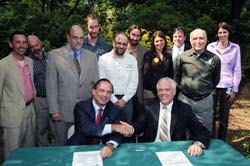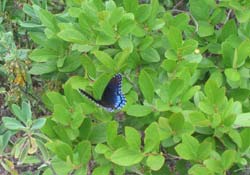The Greenbelt Native Plant Center (GNPC), a facility of the New York City Department of Parks & Recreation, is a 13–acre greenhouse, nursery, and seed bank complex located on Staten Island, NY.
NYC Native Plant Conservation Initiative
Many native plant species found in New York City today would have been quite widespread before urbanization. These native species were a part of large, contiguous populations with unhindered gene flow that maintained population fitness through genetic diversity.
Urbanization, however, has produced significant distances between native plant habitats. It is likely that many plant populations are genetically isolated because these long distances prevent pollen and seed exchange. If this is indeed the case, they are in danger of losing genetic vigor and are susceptible to local extinction. The scientists of the Brooklyn Botanic Garden have now demonstrated that plant populations are declining throughout New York City.
This study will enable us to know if local plant species are maintaining their genetic variability and population fitness, and will allow us to design and implement management strategies to reverse these trends. In 2008, we will begin by piloting the program with an initial 34 species—plants of particular concern in New York City.

September 27, 2008: NYC Parks Commissioner Adrian Benepe and Brooklyn Botanic Garden President Scot Medbury Sign a Memorandum of Understanding to Create the NYC Native Plant Conservation Initiative.
Project
The New York City Native Plant Conservation Initiative
Partners
-
New York City Department of Parks & Recreation (DPR)
- Greenbelt Native Plant Center
- Natural Resources Group (NRG)
- Brooklyn Botanic Garden (BBG)
Rationale
Local plant populations—a group of interbreeding individuals of the same species living in a common geographic location—are the critical units of conservation. It is here that adaptations to climate, soil, insects, and disease occur. Loss of these local populations in our urban landscape means that in the future, what were once self–sustaining ecosystems would have to be maintained as horticultural parkland.
Species-level plant conservation efforts are generally directed towards rare and endangered species threatened by the low number of individuals and/or populations. Both hard scientific data and practical methodologies are available to address the genetic management of these rare plant populations in the wild and as ex–situ collections in botanic gardens and seed banks.
But little attention has been given to the management of rare species in the urban context, and no attempt has been made to assess and manage the more common, yet declining, species found in urban, fragmented populations.
Goals
Conservation of native plant populations within New York City
Objectives
Through this cooperative initiative, we will identify, quantify, and manage the native plant population resources of our city in such a way as to maximize health and long–term sustainability.
Activities

-
Assess the status of all native plants in New York City
- Produce ranked lists of species
- Develop criteria for assessing plant population health, a field data form to conduct assessments, and a database to store assessment data
- Conduct field assessments of plant population health
- Research mating systems, breeding systems, reproductive strategies, and seed and pollen dispersal mechanisms
-
Understand genetic consequences of urbanization
- Study effects of fragmentation and population size
- Use molecular DNA analysis to determine degree of genetic isolation and degree of genetic variability loss and inbreeding
- Develop seed transfer zones—regions within which seeds of plants from one population can be moved with little or no consequence to genetic fitness of another plant population
- Identify target species, determine collection protocols, and collect seed of NYC native species for seed banking
- Prepare and implement recommendations and protocols for restoration and management of native plant populations
-
Raise public awareness of the status of native plants in NYC
- Stage events to draw attention to, raise awareness of, and celebrate our native plants
- Produce educational resources for schools and adults
Related Links
See Manahatta project web site for a glimpse at what Manhattan Island may have looked like prior to Dutch arrival.